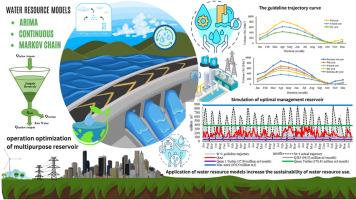The operation optimization of multipurpose reservoir between ARIMA, continuous, and Markov Chain models on Jatigede reservoir, Indonesia
IF 8.7
Q1 Environmental Science
引用次数: 0
Abstract
The critical challenge in reservoir management is optimizing reservoir volume by balancing inflow and outflow discharges. Achieving this balance is essential not only to meet downstream water demands but also to preserve the reservoir's ecological function and structural integrity. Accurate inflow estimation plays an important role in this process, as it directly impacts the calculation of outflow discharges and the stability of reservoir volume. This study aims to compare the performance of the ARIMA (Autoregressive Integrated Moving Average), Continuous, and Markov Chain models in the estimating inflow discharge of Jatigede reservoir in West Java Province, Indonesia as a case study. Many studies conducted for inflow discharge estimation, from the most sophisticated to the simplest. However, the performance of model depends on its accuracy to the observation data. In this study, the results underscore the significance of inflow estimation, showing that the Continuous model yields the highest correlation (0.944), the lowest RMSE (0.408), and MAE (0.115). In contrast, the Markov Chain model exhibits a correlation of 0.923, RMSE of 0.443 and MAE of 0.116, while ARIMA model reports a correlation of 0.792, RMSE of 0.621, and MAE of 0.278. The findings of study indicated that the Continuous model has given better accuracy in inflow estimation, so it the most suitable approach for optimizing reservoir management.

印度尼西亚Jatigede水库ARIMA、连续和马尔可夫链模型的多用途水库运行优化
水库管理的关键挑战是通过平衡流入和流出流量来优化水库容量。实现这种平衡不仅对满足下游用水需求,而且对保护水库的生态功能和结构完整性至关重要。准确的入流估算在这一过程中起着至关重要的作用,因为它直接影响到流出流量的计算和水库体积的稳定性。本研究旨在比较ARIMA(自回归综合移动平均)模型、连续模型和马尔可夫链模型在印度尼西亚西爪哇省Jatigede水库入库流量估算中的性能。对入流流量估算进行了许多研究,从最复杂的到最简单的。然而,模型的性能取决于其对观测数据的准确性。在本研究中,结果强调了流入估计的重要性,表明连续模型的相关性最高(0.944),RMSE最低(0.408),MAE最低(0.115)。Markov Chain模型的相关系数为0.923,RMSE为0.443,MAE为0.116;ARIMA模型的相关系数为0.792,RMSE为0.621,MAE为0.278。研究结果表明,连续模型具有较好的入流估算精度,是优化水库管理的最佳方法。
本文章由计算机程序翻译,如有差异,请以英文原文为准。
求助全文
约1分钟内获得全文
求助全文
来源期刊

Water Cycle
Engineering-Engineering (miscellaneous)
CiteScore
9.20
自引率
0.00%
发文量
20
审稿时长
45 days
 求助内容:
求助内容: 应助结果提醒方式:
应助结果提醒方式:


